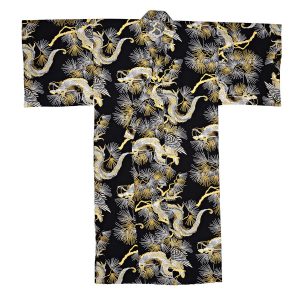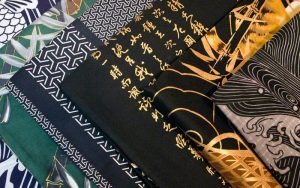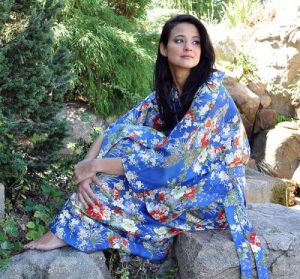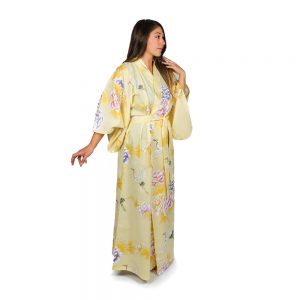In Japanese culture, the dragon, or ryū, is not a creature of fire and destruction. Instead, it is a powerful and benevolent force associated with wisdom, strength, and good fortune. This divine being commands the waters and skies, bringing rain to nourish the land and protecting those it favors. Wearing a dragon on your clothing is more than a style choice; it’s an invitation to embody its auspicious energy. A Japanese robe adorned with a dragon becomes a symbol of personal power and protection.
At Chopa, we have celebrated the art of Japanese textiles for over three decades. Our collection of dragon-themed kimonos and yukatas captures the spirit of this legendary creature. Each piece is expertly crafted in Japan from 100% cotton, offering a blend of authentic design and modern comfort.
The Symbolism of the Dragon
Unlike their Western counterparts, Japanese dragons are seen as guardians. They are complex symbols with deep roots in mythology and spirituality.
- Strength and Power: The dragon is a figure of immense physical and spiritual strength. It represents the ability to overcome obstacles and achieve greatness.
- Wisdom and Protection: As ancient beings, dragons are keepers of profound wisdom. They are often depicted as protectors of temples, treasures, and even entire communities.
- Control Over Water and Sky: Japanese dragons are water deities, living in oceans, rivers, and lakes. They control rainfall, storms, and tides, symbolizing influence over the natural world and the flow of life itself.
- Good Fortune: Sighting a dragon is considered an incredibly lucky omen, promising success, prosperity, and a bountiful future.
When you wear a dragon kimono or yukata, you carry these powerful meanings with you. It’s a statement of confidence, a nod to timeless tradition, and a personal emblem of good fortune.
Chopa’s Dragon Kimono and Yukata Collection
Our curated selection of Japanese robes showcases the dragon in various awe-inspiring forms. Each design tells a unique story, pairing the dragon with other potent symbols from Japanese folklore.
Dragon and Mt. Fuji Yukata
This striking yukata combines two of Japan’s most powerful icons: the dragon and Mount Fuji. The dragon coils protectively around the sacred mountain, creating a design that symbolizes unshakeable strength and national pride. Available in deep navy, bold red, and classic black, this 100% cotton yukata is a masterpiece of cultural expression.
Dragon and Tiger Kimono
The dragon and the tiger are celestial rivals, representing the delicate balance of the universe. The dragon rules the heavens and the rain, while the tiger commands the earth. Together, they symbolize the harmony of opposing forces—spirit and matter, yin and yang. This dynamic Japanese robe is for those who appreciate the interplay of power and grace.
Dragon of Flame Kimono
This design is a true showstopper. The Dragon of Flame Kimono features a large, intricately embroidered dragon across the back, its body ablaze with color and detail. Embroidery adds texture and dimension, making the dragon feel alive. It’s a bold and artistic piece that embodies the creature’s fiery spirit and unstoppable energy.
Dragon and Hawk Yukata
Another powerful pairing, the dragon and hawk represent supremacy over the sky. The hawk is known for its sharp vision and swift action, while the dragon commands the very weather. This yukata design speaks to ambition, clear focus, and the ability to rise above challenges.
Cloud Dragon Yukata
Often depicted among the clouds, the dragon is a master of the celestial realm. The Cloud Dragon yukata captures this ethereal quality, showing the dragon moving gracefully through the heavens. It evokes a sense of freedom, transcendence, and limitless potential.
Modern Style, Traditional Craftsmanship
We understand that style is personal. That’s why many of our dragon designs are available in both traditional, full-length cuts and as shorter Happi Coats. The Happi Coat offers a versatile, modern silhouette that works well as a light jacket over jeans and a t-shirt or as a comfortable lounge robe.
No matter which style you choose, you can be confident in its quality. Every Japanese kimono and yukata from Chopa is made in Japan from soft, breathable 100% cotton.
Experience the Chopa Difference
As a U.S.-based company, we make it simple to bring authentic Japanese style into your life. When you order from Chopa.com, you benefit from quick shipping from within the USA. There are no long waits for international packages or surprise customs fees. We also offer easy returns to ensure you are completely satisfied with your purchase.
Embrace the strength, wisdom, and good fortune of the dragon. Explore our collection of dragon kimonos, yukatas, and Happi Coats to find the design that speaks to your spirit.








